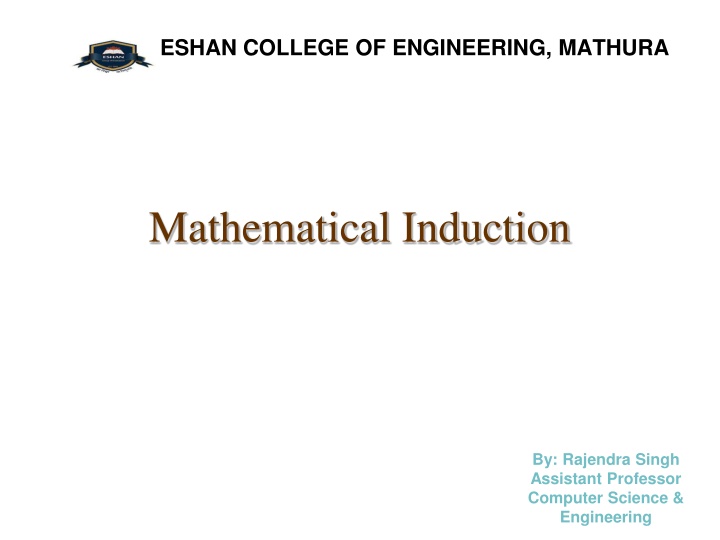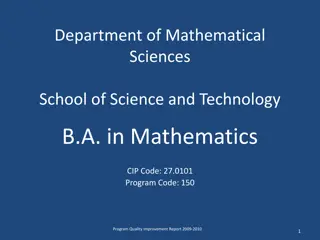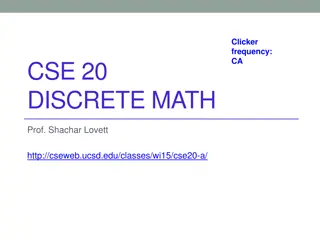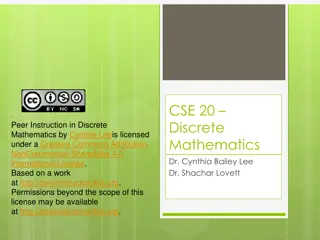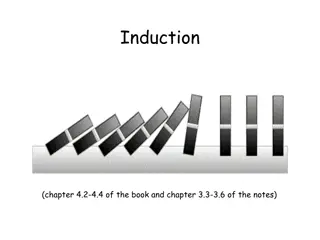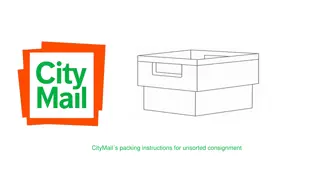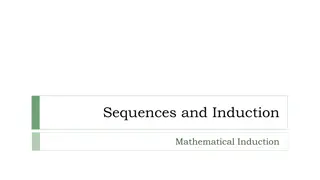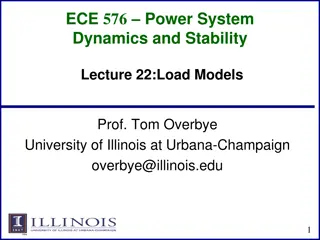Mathematical Induction: Example on Postage Stamps
Mathematical induction is demonstrated through an example involving postage stamps of values 3 and 5. The process generalizes to show that any postage value of 8 can be obtained using these stamps. The step-by-step explanation by Rajendra Singh, Assistant Professor in Computer Science & Engineering at Eshan College of Engineering, Mathura, helps in understanding the concept effectively.
Download Presentation

Please find below an Image/Link to download the presentation.
The content on the website is provided AS IS for your information and personal use only. It may not be sold, licensed, or shared on other websites without obtaining consent from the author.If you encounter any issues during the download, it is possible that the publisher has removed the file from their server.
You are allowed to download the files provided on this website for personal or commercial use, subject to the condition that they are used lawfully. All files are the property of their respective owners.
The content on the website is provided AS IS for your information and personal use only. It may not be sold, licensed, or shared on other websites without obtaining consent from the author.
E N D
Presentation Transcript
ESHAN COLLEGE OF ENGINEERING, MATHURA Mathematical Induction By: Rajendra Singh Assistant Professor Computer Science & Engineering
ESHAN COLLEGE OF ENGINEERING, MATHURA Mathematical Induction: Example Show that any postage of 8 can be obtained using 3 and 5 stamps. First check for a few particular values: 8 = 3 + 5 9 = 3 + 3 + 3 10 = 5 + 5 11 = 5 + 3 + 3 12 = 3 + 3 + 3 + 3 How to generalize this? By: Rajendra Singh Assistant Professor Computer Science & Engineering 2
ESHAN COLLEGE OF ENGINEERING, MATHURA Mathematical Induction: Example Let P(n) be the sentence n cents postage can be obtained using 3 and 5 stamps . Want to show that P(k) is true implies P(k+1) is true 2 cases: 1) P(k) is true and the k cents contain at least one 5 . 2) P(k) is true and the k cents do not contain any 5 . for any k 8 . By: Rajendra Singh Assistant Professor Computer Science & Engineering 3
ESHAN COLLEGE OF ENGINEERING, MATHURA Mathematical Induction: Example Case 1: k cents contain at least one 5 coin. Replace 5 coin by two 3 coins k cents k+1 cents 5 3 3 Case 2: k cents do not contain any 5 coin. Then there are at least three 3 coins. 3 coins by two k cents Replace three k+1 cents 3 5 coins 3 3 5 5 By: Rajendra Singh Assistant Professor Computer Science & Engineering 4
ESHAN COLLEGE OF ENGINEERING, MATHURA Domino Effect Mathematical induction works like domino effect: Let P(n) be The nthdomino falls backward . If (a) P(1) is true ; (b) P(k) is true implies P(k+1) is true Then P(n) is true for every n By: Rajendra Singh Assistant Professor Computer Science & Engineering 5
ESHAN COLLEGE OF ENGINEERING, MATHURA Principle of Mathematical Induction Let P(n) be a predicate defined for Suppose the following statements are true: 1. Basis step: P(a) is true for some fixed a Z . 2. Inductive step: For all integers k a, if P(k) is true then P(k+1) is true. Then for all integers n a, P(n) is true. integers n. By: Rajendra Singh Assistant Professor Computer Science & Engineering 6
ESHAN COLLEGE OF ENGINEERING, MATHURA Example: Sum of Odd Integers Proposition:1 + 3 + + (2n-1) = n2 Proof (by induction): 1) Basis step: The statement is true for n=1: 1=12. 2) Inductive step: Assume the statement is true for some k 1 (inductive hypothesis) , show that it is true for k+1 . for all integers n 1. By: Rajendra Singh Assistant Professor Computer Science & Engineering 7
ESHAN COLLEGE OF ENGINEERING, MATHURA Example: Sum of Odd Integers Proof (cont.): The statement is true for k: 1+3+ +(2k-1) = k2 We need to show it for k+1: 1+3+ +(2(k+1)-1) = (k+1)2 Showing (2): 1+3+ +(2(k+1)-1) = 1+3+ +(2k+1) = 1+3+ +(2k-1)+(2k+1) = We proved the basis and inductive steps, so we conclude that the given statement true. (1) (2) by (1) k2+(2k+1) = (k+1)2 . By: Rajendra Singh Assistant Professor Computer Science & Engineering
ESHAN COLLEGE OF ENGINEERING, MATHURA Important theorems proved by mathematical induction Theorem 1 (Sum of the first n integers): For all integers n 1, ) 1 + ( n n + + + = 1 2 ... n 2 Theorem 2 (Sum of a geometric sequence): For any real number r except 1, and any integer n 0, = i + 1 n 1 n r = i r 1 r 0 By: Rajendra Singh Assistant Professor Computer Science & Engineering 9
ESHAN COLLEGE OF ENGINEERING, MATHURA Example (of sum of the first n integers) In a round-robin tournament each of the n teams plays every other team exactly once. What is the total number of games played? Solution on the board. By: Rajendra Singh Assistant Professor Computer Science & Engineering 10
ESHAN COLLEGE OF ENGINEERING, MATHURA Proving a divisibility property by mathematical induction Proposition: For any integer n 1, 7n - 2n is divisible by 5. (P(n)) Proof (by induction): 1) Basis step: The statement is true for n=1: 71 21 = 7 - 2 = 5 is divisible by 5. 2) Inductive step: Assume the statement is true for some k 1 (P(k)) (inductive hypothesis) ; show that it is true for k+1 . (P(1)) (P(k+1)) By: Rajendra Singh Assistant Professor Computer Science & Engineering 11
ESHAN COLLEGE OF ENGINEERING, MATHURA Proving a divisibility property by mathematical induction Proof (cont.): We are given that P(k): 7k - 2k is divisible by 5. Then7k - 2k = 5a for some a Z . (by definition) (2) We need to show: P(k+1): 7k+1 - 2k+1 is divisible by 5. 7k+1 - 2k+1 = 7 7k - 2 2k = 5 7k + 2 7k - 2 2k = 5 7k + 2 (7k - 2k) = 5 7k + 2 5a (by (2)) = 5 (7k + 2a) which is divisible by 5. (by def.) Thus, P(n) is true by induction. (1) (3) By: Rajendra Singh Assistant Professor Computer Science & Engineering 12
